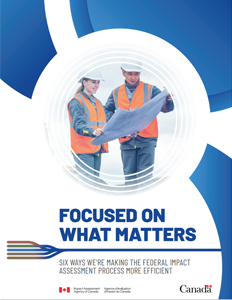Focused on what matters: Six ways we’re making the federal impact assessment process more efficient

Focused on what matters: Six ways we're making the federal impact assessment process more efficient
(PDF version - 2.9 MB)
1. Cooperating more with other jurisdictions to support the principle of one project, one review:
- Negotiating cooperation agreements with provinces so they can lead impact assessments (a process known as substitution)
- Developing project-specific agreements with provinces, territories, and Indigenous Peoples
- Updating Memoranda of Understanding with the Canadian Nuclear Safety Commission
Real progress: Substitution in action
- Assessment of Cedar LNG project completed in 3.5 years
- Ksi Lisims LNG project (proposed facility to liquify natural gas) in British Columbia is on track for a decision in 2025
- Two other projects are currently being assessed by the Government of British Columbia
2. Reducing the burden on project proponents
- Eliminating duplication of work required to meet federal and provincial requirements
- Developing standard mitigation measures and targets for routine issues
- Narrowing our focus:
- ensuring the Summary of Issues is centered on what’s important to Canadians
- limiting our attention to areas of federal jurisdiction for provincially regulated projects, such as mines
- tailoring the Impact Statement Guidelines to concentrate on areas most important to decision-making
What people are saying: Strange Lake Mine Project
"We entered into the discussion with NG [Nunatsiavut Government] and the Government of Canada and the Government of Newfoundland and Labrador and we were so impressed with how they all were willing to collaborate on our file that we could use one impact assessment document for all of them, as long as it met all of their criteria."
3. Helping communities and proponents get ready
- Providing proponents with guidance and advice early and frequently
- Engaging early to help Indigenous and non-Indigenous communities prepare for assessments
- Coordinating information with federal authorities
- Identifying issues early so they can be resolved quickly
4. Making more timely decisions
- Requests to designate a project can be addressed by IAAC president (deciding whether a project not on the Project List should be considered for a federal assessment)
- No need for a Detailed Project Description if we have enough information to make a screening decision (whether a project needs a federal assessment)
Real progress:
- Federal assessments for 13 projects completed in an average of 96 days
- Assessment for Big Bear Camp Aerodrome project in Saskatchewan completed in 59 days
5. Improving client service
- Integrating requirements for impact assessments and permits to streamline processes
- Improving the permit process by developing detailed plans and timelines and coordinating requirements for proponents
- Increasing transparency through online public information dashboards
- Providing advice early and frequently throughout the process
Real progress:
- All federal permits for the Marathon Palladium Mine in Ontario completed in 15 months
What people are saying: Crawford Nickel Mine Project
"We’ve gone from the fifth drillhole in September 2019 to become the first mining project in Canada to file an Impact Statement under the 2019 Impact Assessment Act. The ability to achieve this milestone in just over five years also reflects the federal government’s commitment to timely and efficient permitting processes and effective engagement with proponents."
6. Strengthening relationships with Indigenous Peoples
- Currently consulting with more than 300 Indigenous communities on active assessments
- Engaging early in constructive dialogue with governments, proponents, and Indigenous communities
- Aligning our processes with the governance structure and protocols of Indigenous communities
- Working to understand and address potential impacts of a project on the rights and interests of Indigenous communities
- Supporting Indigenous leadership in impact assessment
Real progress:
- To support the creation of Indigenous impact assessment co-administration agreements, we:
- met with more than 49 Indigenous partners
- are currently reviewing 44 written submissions from these groups
What people are saying: Marathon Palladium Mine
"Biigtigong Nishnaabeg and the Crown worked to build a collaborative relationship throughout the environmental assessment for the project.
"The project is on the Exclusive Aboriginal title territory of Biigtigong Nishnaabeg and since the community is the most highly impacted by the proposed project, the Crown needed to provide Biigtigong Nishnaabeg with supports and resources that would accommodate for impacts and enable the community to benefit from the project.
"The Crown recognized and respected Biigtigong Nishnaabeg’s requirement for a consensus-based process, and we believe we have set a new precedent for how the government can and should work with First Nations on a Nation-to-Nation basis in decision-making."